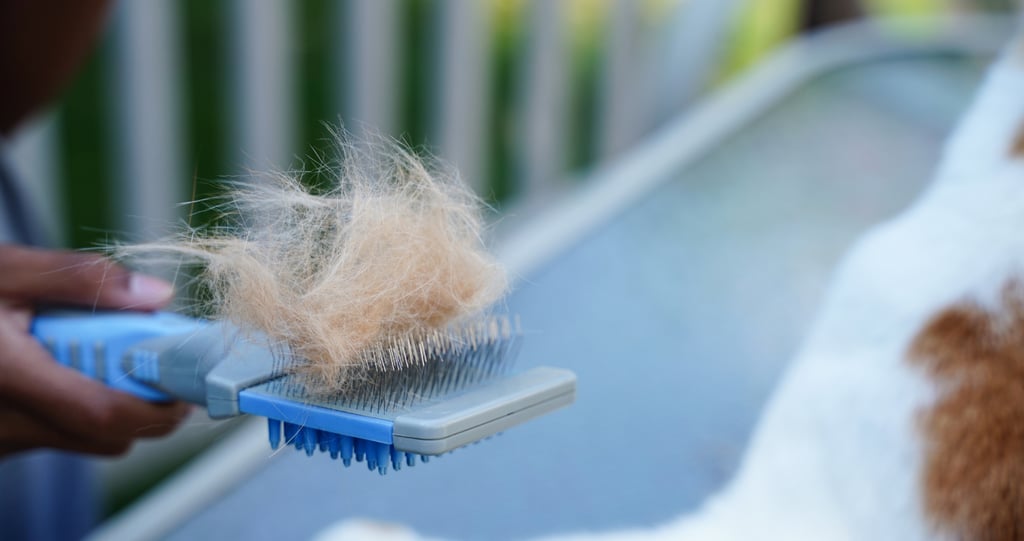Why Is my pet shedding so much hair? Causes and solutions
Understand why your dog or cat sheds so much hair and how to reduce it through nutrition, grooming, and vet-approved care routines.
8/13/20253 min read


Shedding is completely natural in dogs and cats — but when it becomes excessive, it can worry any pet parent. Finding clumps of fur on the floor, sofa, clothes, or car seats may signal anything from a normal seasonal change to an underlying health issue.
Understanding what causes shedding and adopting the right care habits are key to keeping your pet healthy - and your home cleaner.
Shedding: what’s normal and what’s too much?
All pets shed, especially when the seasons change and their bodies adapt to temperature differences. This process is known as “molting,” and it’s part of the natural hair cycle.
However, shedding may be considered excessive when:
Bald patches appear in the coat.
The skin shows redness, itching, or scabs.
The pet constantly licks or bites certain areas.
There’s a sudden change in the amount of hair being lost.
Quick tip: Not all shedding is a sign of illness — but sudden changes deserve attention.
Main causes of excessive shedding
Excessive fur loss can be linked to both internal and external factors. The most common include:
Seasonal changes – especially spring and autumn.
Poor diet – lack of protein, vitamins, and fatty acids affects coat health.
Stress and anxiety – changes in environment or routine can trigger shedding.
Allergies – to food, dust, pollen, or cleaning products.
External parasites – fleas, ticks, or mites.
Hormonal imbalances – such as hypothyroidism or Cushing’s disease.
Skin conditions – dermatitis or fungal infections.
If your pet is shedding heavily and showing other symptoms, consult a veterinarian for proper diagnosis.
How to reduce your pet’s shedding
While it’s impossible to stop shedding entirely, consistent care can minimize it and improve coat health.
1. Quality Nutrition
Choose premium or super-premium pet food rich in protein and essential fatty acids (omega-3 and omega-6).
Consider vitamin supplements recommended by your vet when needed.
2. Regular Brushing
Brush daily (or at least three times a week) to remove loose hair.
Use grooming tools appropriate for your pet’s coat type — slicker brushes, de-shedding combs, or gloves.
3. Proper Bath Routine
Too many baths can dry out the skin.
Use pet-specific, hypoallergenic shampoos to protect natural oils.
4. Parasite Control
Keep up with flea and tick prevention as recommended by your vet.
Clean bedding, carpets, and the environment regularly.
5. Stress Management
Provide a calm, predictable environment.
Maintain a consistent schedule of walks, meals, and playtime.
When shedding could signal a health issue
Some signs may indicate that hair loss is linked to a medical problem:
Irregular or localized bald spots.
Persistent itching or scratching.
Scabs, sores, or unpleasant skin odor.
Loss of appetite or behavioral changes.
Important: If any of these appear, schedule a vet visit. A professional evaluation can identify the cause and guide effective treatment.
The veterinarian’s role in coat health
A veterinarian may order tests to detect nutritional deficiencies, allergies, or hormonal issues. With the right treatment plan and routine adjustments, excessive shedding often improves quickly.
Don’t wait for the problem to worsen — preventive checkups are simpler and more affordable than long-term treatments.
Conclusion
Shedding is a natural process, but when it becomes excessive, it’s a sign to look closer. Through proper nutrition, regular brushing, gentle baths, and veterinary guidance, you can reduce hair loss and keep your pet’s coat strong and shiny.
Remember: a healthy, beautiful coat reflects your pet’s overall well-being. Investing in these small habits means investing in your pet’s quality of life.
Observe your pet daily, stay consistent with care, and give lots of love — you’ll see the difference in both the health of their coat and their happiness.
Health
Tips for a healthy and balanced life.
© 2025. All rights reserved.
Well-being
Privacy Policy
Terms and conditions
